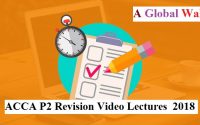ACCA P3 BPP Exam Tips for December 2017
ACCA P3 BPP Exam Tips for December 2017
YOUR P3 EXAM TIPS
BPP’s Big Tip: Students must not underestimate the importance of practicing the 50-marker to help their time management in the real thing. ACCA P3 BPP Exam Tips for December 2017.
Examiner’s Big Tip: The syllabus for P3 is very broad, admits the examiner, and is unlikely to be covered in its entirety during a short, taught course.
What BPP said:
Section A continues to consume time in reading and absorbing – three pages of text and numbers are becoming the norm. So, practice these questions – not only from a knowledge point of view but more critically from a time management and effort perspective.
Section B questions are more likely to examine discrete subject areas. We have seen calculations examined in the optional section B questions as well as in the compulsory section A question. This is a trend that is expected to continue. A good study strategy is to include time to revisit the numerical areas of the syllabus to refresh knowledge is advised.
A review of past exams reveals that all the key areas of the syllabus have been examined (sometimes the same topic that appeared in consecutive sittings) shows the danger of question spot.

What the Examiner said about the September sitting:
General Comments
The syllabus for P3 is very broad, admits the examiner, and is unlikely to be covered in its entirety during a short, taught course.
The examiner asked lecturers to ensure they signpost the remaining content to candidates for their own learning.
He says it is apparent in exam papers that some areas have been missed by candidates, or at least not in sufficient depth.
Q1
Part a) required candidates to analyze the strategic change by applying given elements of the Balogun and Hope Hailey model, with the use of performance data. For part b) candidates needed to use the POPIT model. The final part of this question focused on the customers and why they may not accept changes.
Q2
Started with a discussion of Mendelow’s matrix and the application of the matrix to given stakeholder groups. Part b) required a discussion of the responsibilities of named project personnel.
Q3
Part a) required the preparation of a decision tree and an evaluation of the options and the method and data used. Candidates were then asked to discuss the forms of finance which could be used for the selected option.
Q4
This covered a topic that usually appears in Q1 – a SWOT analysis and an Ansoff’s matrix.







Please provide me P3 Study text